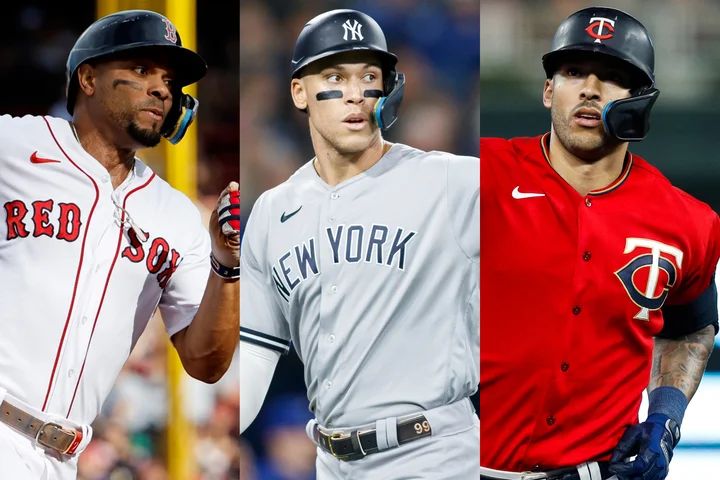The MLB free agent (FA) market is currently in an unprecedented bubble.
One after another, top players are signing big contracts that exceed all previous expectations.
The following is a summary of the major players (expected contract amounts are based on “MLB Trade Rumors”).
▼ Aaron Judge, OF.
Yankees to Yankees.
Projected contract: 8 years, $332 million
Actual contract: 9 years, $360 million
▼ Carlos Correa (SS)
Twins → Giants
Projected contract: 9 years, $288 million
Actual contract: 13 years, $350 million
▼ Trey Turner (SS)
Dodgers to Phillies
Projected contract: 8 years, $268 million
Actual contract: 11 years, $300 million
▼ Xander Bogaerts (SS)
Red Sox → Padres
Projected contract: 7 years, $189 million
Actual contract: 11 years, $280 million
▼Dansby Swanson (SS)
Braves → Cubs
Projected contract: 7 years, $154 million
Actual contract: 7 years, $177 million
▼ Carlos Rodon.
Giants → Yankees
Projected contract: 5 years, $140 million
Actual contract: 6 years, $162 million
▼Jacob deGrom, SP
Mets → Rangers
Projected contract: 3 years, $135 million
Actual contract: 5 years, $185 million
▼ Brandon Nimmo (OF)
Mets → Mets
Projected contract: 5 years, $110 million
Actual contract: 8 years, $162 million
As you can see from the list, all of them have concluded big deals that far exceeded expectations. Judge’s 9-year, $360 million deal with the Yankees is the most expensive FA contract ever. It is followed by Correa’s 13-year, $350 million. Turner also tied for sixth place, and Bogaerts ranked eighth. Jason Stark of The Athletic, a U.S. media outlet, quoted one team executive as describing the current situation of literally a string of historic contracts as “insanity.
The market for starting pitchers in particular has skyrocketed greatly, so much so that even Matthew Boyd, who has pitched only 13.1 innings this season, was given a one-year, $10 million contract. Why was the FA market so “crazy” this offseason? Ken Rosenthal, also of The Athletic, cited the following five factors as the forces at work in the market.
1: This is the first full off-season since the new labor agreement was signed.
A new labor-management agreement was signed in March of this year after the lockout, the biggest labor battle since the 1994-95 strike. According to Rosenthal, owners often sign large contracts after labor-management conflicts in order to repair relations with the players. It appears that they are following this pattern this time as well.
2: Recovering from the loss of revenue caused by the Corona disaster
According to Commissioner Rob Manfred, MLB’s overall revenue for this season will be nearly $11 billion. This is more than even 2019 ($10.7 billion) before the Corona disaster. The increase in revenue appears to be a result of the booming FA market.
3: Distribution of the massive streaming rights deal with Disney
In November, MLB sold 15% of its streaming broadcast rights (the remaining 85% is owned by BAMTech) to The Walt Disney Company for $900 million. As a gain on the sale, $30 million per team was distributed.
4: Raising the luxury tax line
Related to the first point, the new labor agreement raised the line for the luxury tax, which is imposed when the total annual salary exceeds a certain amount (from $210 million to $233 million). This has led to aggressive reinforcements by the Padres, Mets, and other teams.
5: Expansion of playoff slots
This was also a decision of the labor-management agreement last offseason, expanding the number of playoff berths from 10 to 12 teams starting in 2010. And with the Phillies winning the league championship after finishing third in the district with an 87-75 record in the regular season, more teams have followed suit and begun aggressively reinforcing their teams.
In short, Rosenthal’s analysis is that the combination of “increased team funds” and “an environment that made it easier for teams to aggressively reinforce their roster” made it a seller’s market for FA players. ……
In addition to this, Stark also analyzes the psychological impact of the “frenzy” of the market itself on the front office of a baseball team. An executive of a mid-size team said, “As I watch the FA contracts being finalized, I get scared that we are going to miss out on all the good players. This is a really hard emotion to control,” he says.
In fact, this offseason, the Mets, Padres, and Rangers have made major reinforcements. The Mets, in particular, have been “bombing” their market, with their total annual salary exceeding $300 million for the first time in their history. The aggressive reinforcements by some of these teams must have made other teams impatient. This bubble was caused by a combination of various factors. It can be said that the players who benefited from this bubble were lucky.


コメント